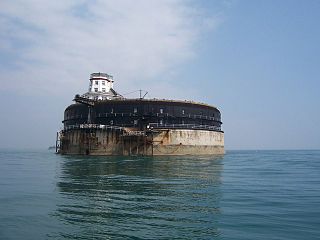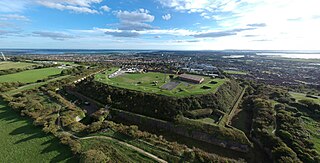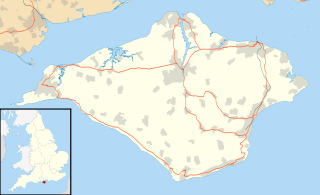
Portsmouth is an English port city primarily built on Portsea Island in the county of Hampshire. It is also known as Pompey, a nickname shared with HMNB Portsmouth and the Portsmouth Football Club. The United Kingdom's only island city, it is 70 miles (110 km) south-west of London and 19 miles (31 km) south-east of Southampton. Portsmouth's population was 205,100 in the 2011 UK Census. The city is part of the South Hampshire metropolitan area, which also includes the city of Southampton and the towns of Gosport, Fareham, Waterlooville, Havant and Eastleigh.

Gosport is a town in Hampshire on the south coast of the United Kingdom. At the 2011 Census, its population was 91,544 It is situated on a peninsula on the western side of Portsmouth Harbour, opposite the city of Portsmouth, to which it is linked by the Gosport Ferry. Gosport lies south-east of Fareham, to which it is linked by a Bus Rapid Transit route and the A32. Until the last quarter of the 20th century, Gosport was a major naval town associated with the defence and supply infrastructure of Her Majesty's Naval Base (HMNB) Portsmouth. As such over the years extensive fortifications were created.

The fortifications of Portsmouth are extensive due to its strategic position on the English Channel and role as home to the Royal Navy. For this reason, Portsmouth was, by the 19th century, one of the most fortified cities in the world. The fortifications have evolved over the centuries in response to changes in tactics and technology and the area defended has increased. While the first defences focused on Portsmouth harbour, in step with the fortifications of Gosport, later defensive structures protected the whole of Portsea Island and an increasing distance inland. At the same time, the fortifications of Portsmouth and Gosport became part of the wider fortifications of the Solent. Old Portsmouth, on the southwest corner of Portsea Island, has been walled for much of its history.

Portsdown Hill is a long chalk ridge in Hampshire, England. The highest point of the hill lies within Fort Southwick at 131m above sea level. The ridge offers good views to the south over Portsmouth, the Solent, Hayling Island and Gosport, with the Isle of Wight beyond. The hill is on the mainland, just to the north of Ports Creek, which separates the mainland from Portsea Island, on which lies the main part of the city of Portsmouth, one of the United Kingdom's main naval bases. To the north lies the Forest of Bere, with the South Downs visible in the distance. Butser Hill can be seen on a clear day. The hill is formed from an inlier of chalk which has been brought to the surface by an east-west upfold of the local strata known as the Portsdown Anticline.

Spitbank Fort or Spitsand Fort or Spit Sand Fort or simply Spit Fort is a sea fort built as a result of the 1859 Royal Commission. The fort is one of four built as part of the Palmerston Forts constructions. Located in the Solent, near Portsmouth, England, and is now a luxury hotel.

St Helens Fort is a sea fort in the Solent close to the Isle of Wight, one of the Palmerston Forts near Portsmouth. It was built as a result of the Royal Commission on the Defence of the United Kingdom of 1859, in order to protect the St Helens anchorage.

No Man's Land Fort, also referred to as No Man's Fort, is a sea fort in the Solent, near Portsmouth, England. It is one of the Palmerston Forts built between 1867 and 1880 after the recommendations of the 1859 Royal Commission. It is 200 feet in diameter, and lies 1.4 miles off the coast of the Isle of Wight.

Horse Sand Fort is one of the larger Royal Commission sea forts in the Solent off Portsmouth, Hampshire, England. The fort is one of four built as part of the Palmerston Forts constructions. It is 200 feet (61 m) across, built between 1865 and 1880, with two floors and a basement and armour-plated all round.

The Royal Commission on the Defence of the United Kingdom was a committee formed in 1859 to enquire into the ability of the United Kingdom to defend itself against an attempted invasion by a foreign power, and to advise the British Government on the remedial action required. The appointment of the Commission had been prompted by public concern about the growing military and naval power of the French Empire and was instigated by the Prime Minister, Henry Temple, 3rd Viscount Palmerston, who came to be closely associated with the project. In the following year, the Commission's report recommended a huge programme of fortification to defend the country's arsenals and naval bases. Many of the recommendations were acted upon; however, the great expense, the length of time taken to complete the various works and their perceived usefulness were all subjects of critical political, press and public debate.

Fort Widley is one of the forts built on top of Portsdown Hill between 1860 and 1868 on the recommendation of the Royal Commission on the Defence of the United Kingdom. It was designed, along with the other Palmerston Forts atop Portsdown, to protect Portsmouth from attack from the rear.

Portsmouth Harbour is a 1,264.2-hectare (3,124-acre) biological Site of Special Scientific Interest between Portsmouth and Gosport in Hampshire. It is a Ramsar site and a Special Protection Area.

Fort Nelson, in the civil parish of Boarhunt in the English county of Hampshire, is one of five defensive forts built on the summit of Portsdown Hill in the 1860s, overlooking the important naval base of Portsmouth. It is now part of the Royal Armouries, housing their collection of artillery, and a Grade I Listed Building.

The Palmerston Forts are a group of forts and associated structures built during the Victorian period on the recommendations of the 1860 Royal Commission on the Defence of the United Kingdom. The name comes from their association with Lord Palmerston, who was Prime Minister at the time and promoted the idea.

Bembridge Fort is a fort built on the highest point of Bembridge Down close to the village of Bembridge on the Isle of Wight, England. It is one of the many Palmerston Forts built around Portsmouth during the period of the Second French Empire, as a safeguard against a perceived threat of French invasion by Napoleon III.

Culver Battery is a former coastal artillery battery on Culver Down, on the eastern side of the Isle of Wight, England. The fortification is one of several Palmerston Forts built on the island following concerns about the size and strength of the French Navy in the late 19th century. It was operational during the First and Second World Wars. The battery was closed in 1956.
Camp Down is a location at Portsdown Hill, Hampshire, near Farlington which was used as an Admiralty semaphore station and later as a redoubt on the line of Palmerston Forts, Portsmouth.

Lumps Fort is a disused fortification built on Portsea Island as part of the defences for the naval base at Portsmouth.
Many forts and fortifications have been built to protect the Isle of Wight from foreign invasion. Throughout history the island has been a site of key military importance. Controlling both entrances to the Solent and the home of the Royal Navy, Portsmouth. This is a list of most of the fortifications on the island.

The Stokes Bay Lines were part of the great Victorian fortification of Portsmouth Harbour under Lord Palmerston. In 1857 Major Jervois had proposed a complex system of moats (ditches), ramparts and batteries to close off the gap between the new fort at Fort Gomer, and the earlier fort at Fort Gilkicker, and Fort Monckton. This defensive moat was to become the ‘Stokes Bay Lines’.

The fortifications of Plymouth in Devon are extensive due to its natural harbour, its commanding position on the Western Approaches and its role as the United Kingdom's second largest naval base after Portsmouth. The first medieval defences were built to defend Sutton Harbour on the eastern side of Plymouth Sound at the mouth of the River Plym, but by the 18th century, naval activity had begun to shift westward to Devonport at the mouth of the River Tamar. During the Victorian era, advances in military technology led to a huge programme of fortification encompassing the whole of Plymouth Sound together with the overland approaches. Many of these works remained in military use well into the 20th century.


















